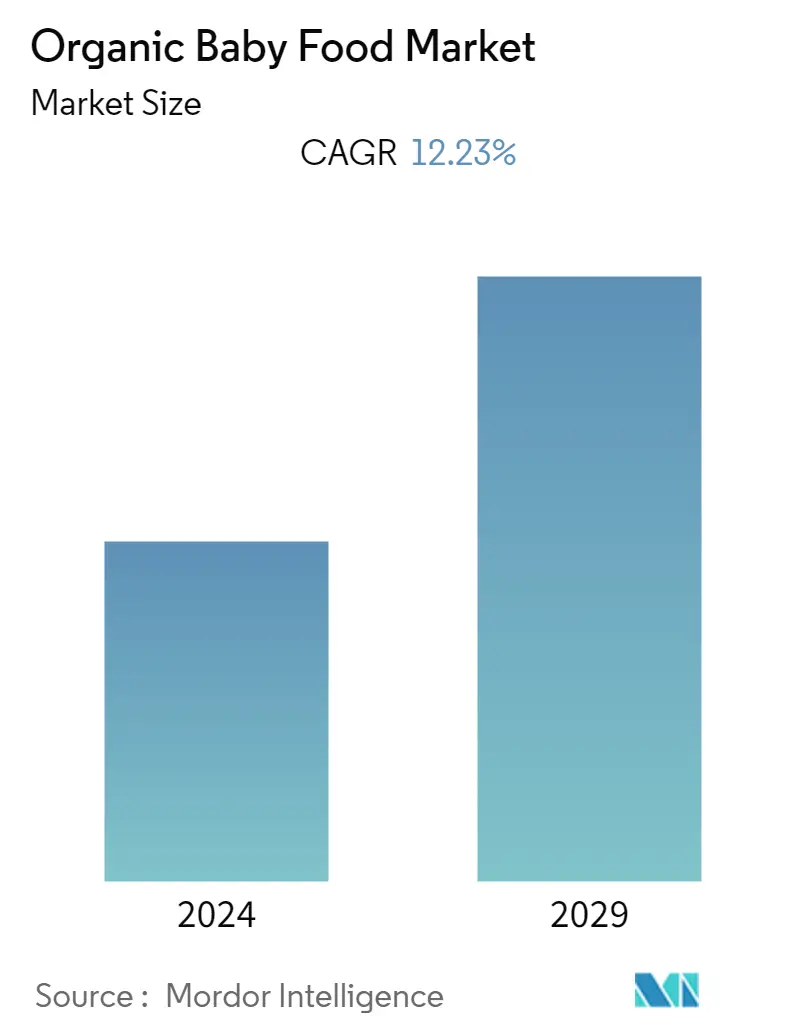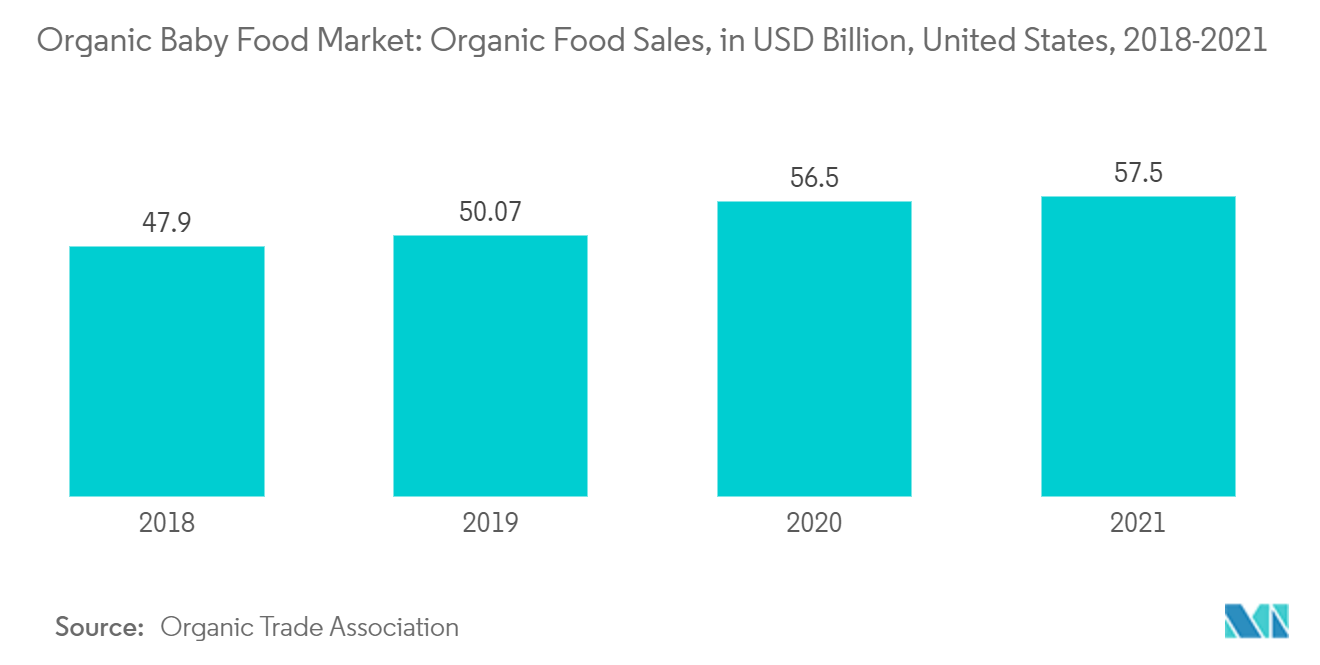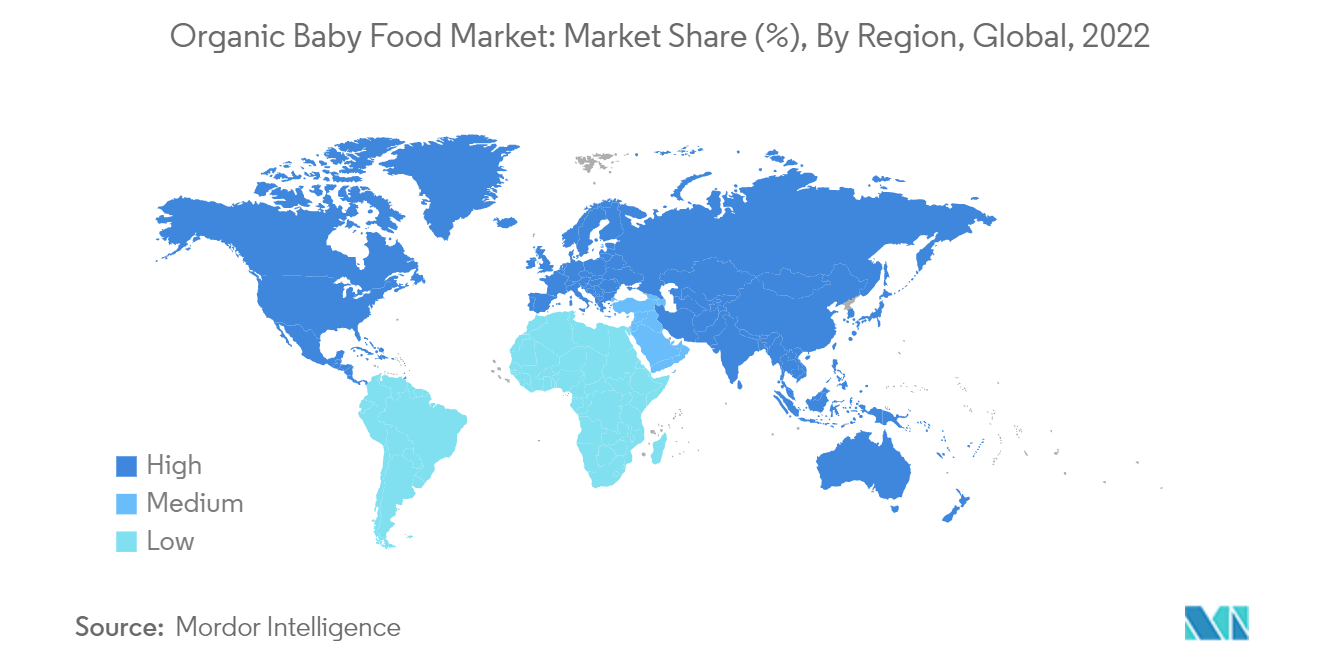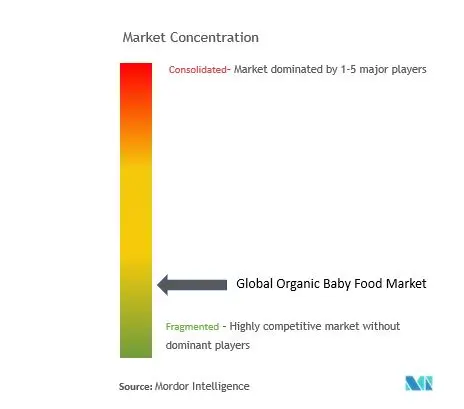Organic Baby Food Market Size

| Study Period | 2019 - 2029 |
| Base Year For Estimation | 2023 |
| CAGR | 12.23 % |
| Fastest Growing Market | Asia Pacific |
| Largest Market | Asia Pacific |
| Market Concentration | Low |
Major Players.webp)
*Disclaimer: Major Players sorted in no particular order |
Organic Baby Food Market Analysis
The Organic Baby Food Market size is expected to grow from USD 4.55 billion in 2023 to USD 8.10 billion by 2028, at a CAGR of 12.23% during the forecast period (2023-2028).
Health crises and food scare had a long-term impact on consumer demand during the COVID-19 pandemic. Initially, there was a sales spike, as consumers feared food safety, and personal health drove product purchases.
The market is driven by the growing awareness among consumers to limit the baby's exposure to the harmful chemicals used in conventional food production and the awareness of the benefits of organic products. Additionally, the rise in the population of working women worldwide largely contributed to the increased size of the prepared organic baby food sector, making it one of the significant growing segments.
The market is driven by the trend toward clean-label products and cleaner diets. Consumers worldwide are increasingly reaching for fresher and healthier food options for themselves, and they are also demanding the same for their children.
Organic Baby Food Market Trends
Escalating Strategic Investments in Organic Baby Food
The popularity of organic baby food is growing, with dedicated aisles for the category. With the increased disposable income, parents can compensate for homemade food with branded organic baby food, posing a great driving factor in both developed and developing countries during the forecast period. Thus, there are increasing investments in the organic baby food sector. For instance, in 2021, Neptune Wellness Solutions acquired a 50.1% share in Sprout Foods plant-based baby food company. The deal included a USD 6 million cash payment and the issuance of approximately 6.7 million in Neptune common shares, valued at USD 12 million. The company registered annual net revenues of USD 28 million.
Baby food start-ups are now differentiating their brands based on specific health goals, from better digestion to brain development, baby-led weaning, and allergy prevention. For example, NurturMe, a portfolio company of Advantage Capital, was acquired by Grays Peak Capital. NurturMe provides baby food and children's snacks that emphasize healthy digestion.
As a result of rising investments in developing and promoting organic food and beverages (including infant food), sales have witnessed a rise in demand over the past few years. As per data published by the Organic Trade Association, in 2021, the United States sold roughly USD 57.5 billion worth of organic food. Nevertheless, companies are investing in R&D to produce products by the standards, which are anticipated to enhance the growth of the organic baby food market during the forecast period.

Asia-Pacific Holds the Largest Share
The relaxation of China's one-child policy may also positively impact pre-packaged baby foods. The potential of increasing wealth and the rising number of newborns give China's baby food and drink manufacturers adequate stimulus to develop packaged organic food products to cater to the consumer demand for better quality organic baby food and drink. Other Asian countries like India and Australia are anticipated to exhibit strong growth in demand for organic infant food products. Thus, many start-ups have come forward to take advantage of the lucrative opportunities offered by the market. In February 2023, Timios, an Indian start-up with headquarters in Bengaluru that sells packaged nutritious snacks for kids, entered the baby food industry by introducing its new made-to-order organic porridge variety for infants and toddlers. The new line, which came in 12 variations, was created with the nutritional needs of infants between the ages of 6 and 8 months in mind.
As per the Global Organic Trade, the market for organic packaged food and beverage in Japan was worth around USD 597.4 million, with a per capita income of USD 4.71. This market size and the increasing prevalence of pre-cooked foods for babies also impacted the market for organic baby food.

Organic Baby Food Industry Overview
In the organic baby food market, companies are focused on developing new marketing strategies and introducing new products based on value-added ingredients to compete in the market. Some major organic baby food-producing companies are Nestle SA, The Hain Celestial Group Inc., Hero Group, Sun-Maid Growers of California, and Danone SA. There is a wide range of private-label brands, particularly the supermarket/hypermarket chains in developed markets and traditional grocery stores/convenience stores/specialty retail stores/health stores in developing economies. The growing demand from the Asia-Pacific region is expected to change the market dynamics in the coming years, as many private-label players are entering the region. Hence, the market studied is fragmented in nature. The players in the market have been using strategies like product innovations, mergers, and acquisitions to thrive in the market studied.
Organic Baby Food Market Leaders
-
Danone SA
-
Nestlé S.A.
-
The Hain Celestial Group, Inc.
-
Sun-Maid Growers of California
-
Hero Group
*Disclaimer: Major Players sorted in no particular order

Organic Baby Food Market News
- April 2022: Gerber introduced an entirely organic plant-based line. A variety of organic pouches, snacks, and meals called Plant-tastic are manufactured solely from plant protein sources. The action follows Gerber's announcement in 2021 that it would work to produce more eco-friendly products. The Carbon Trust has certified Plant-tastic as carbon neutral.
- March 2021: Sun-Maid Growers of California acquired Plum Organics, a premium, organic baby food and kids snack brand, from Campbell Soup Company. Plum Organics offers a wide range of product portfolios for organic foods and snacks to meet the nutritional needs of babies, tots, and kids. Plum Organics' products are certified organic and non-GMO.
- January 2021: Hero Group acquired Baby Gourmet, a Canadian organic meal and snack brand for babies and toddlers. The acquisition included Slammers Snacks, a Baby Gourmet-owned organic children's snacks brand. The financial terms of the transaction were not disclosed.
Organic Baby Food Market Report - Table of Contents
1. INTRODUCTION
- 1.1 Study Deliverables and Study Assumptions
- 1.2 Scope of the Study
2. RESEARCH METHODOLOGY
3. EXECUTIVE SUMMARY
4. MARKET DYNAMICS
- 4.1 Market Drivers
- 4.2 Market Restraints
-
4.3 Porter's Five Forces Analysis
- 4.3.1 Threat of New Entrants
- 4.3.2 Bargaining Power of Buyers/Consumers
- 4.3.3 Bargaining Power of Suppliers
- 4.3.4 Threat of Substitute Products
- 4.3.5 Intensity of Competitive Rivalry
5. MARKET SEGMENTATION
-
5.1 Type
- 5.1.1 Milk Formula
- 5.1.2 Prepared Baby Food
- 5.1.3 Dried Baby Food
-
5.2 Distribution Channel
- 5.2.1 Supermarkets/Hypermarkets
- 5.2.2 Convenience Stores
- 5.2.3 Online Retail Stores
- 5.2.4 Other Distribution Channels
-
5.3 Geography
- 5.3.1 North America
- 5.3.1.1 United States
- 5.3.1.2 Canada
- 5.3.1.3 Mexico
- 5.3.1.4 Rest of North America
- 5.3.2 Europe
- 5.3.2.1 United Kingdom
- 5.3.2.2 Germany
- 5.3.2.3 France
- 5.3.2.4 Russia
- 5.3.2.5 Italy
- 5.3.2.6 Spain
- 5.3.2.7 Rest of Europe
- 5.3.3 Asia-Pacific
- 5.3.3.1 India
- 5.3.3.2 China
- 5.3.3.3 Japan
- 5.3.3.4 Australia
- 5.3.3.5 Rest of Asia-Pacific
- 5.3.4 South America
- 5.3.4.1 Brazil
- 5.3.4.2 Argentina
- 5.3.4.3 Rest of South America
- 5.3.5 Middle East and Africa
- 5.3.5.1 South Africa
- 5.3.5.2 Saudi Arabia
- 5.3.5.3 Rest of Middle East and Africa
6. COMPETITIVE LANDSCAPE
- 6.1 Strategies Adopted by Leading Players
- 6.2 Market Position Analysis
-
6.3 Company Profiles
- 6.3.1 Abbott Laboratories
- 6.3.2 Nestlé SA
- 6.3.3 Hero Group
- 6.3.4 Danone SA
- 6.3.5 Amara Organics
- 6.3.6 Sun-Maid Growers of California
- 6.3.7 North Castle Partners LLC
- 6.3.8 Groupe Lactalis
- 6.3.9 Hipp Gmbh & Co.
- 6.3.10 The Hein Celestial Group Inc.
- 6.3.11 Neptune Wellness Solutions (Sprout Organic Baby Food)
- *List Not Exhaustive
7. MARKET OPPORTUNITIES AND FUTURE TRENDS
** Subject To AvailablityOrganic Baby Food Industry Segmentation
Organic baby foods are grown or processed without synthetic fertilizers or pesticides. The organic baby food market is segmented by type, distribution channel, and geography. By type, the segmentation includes milk formula, prepared baby food, and dried baby food. By distribution channel, the market is segmented into supermarkets/hypermarkets, convenience stores, online retail stores, and other distribution channels. The study analyzes the organic baby food market in emerging and established markets worldwide, including North America, Europe, Asia-Pacific, South America, and Middle East and Africa. The market sizing has been done in value terms in USD for all the abovementioned segments.
| Type | Milk Formula | |
| Prepared Baby Food | ||
| Dried Baby Food | ||
| Distribution Channel | Supermarkets/Hypermarkets | |
| Convenience Stores | ||
| Online Retail Stores | ||
| Other Distribution Channels | ||
| Geography | North America | United States |
| Canada | ||
| Mexico | ||
| Rest of North America | ||
| Geography | Europe | United Kingdom |
| Germany | ||
| France | ||
| Russia | ||
| Italy | ||
| Spain | ||
| Rest of Europe | ||
| Geography | Asia-Pacific | India |
| China | ||
| Japan | ||
| Australia | ||
| Rest of Asia-Pacific | ||
| Geography | South America | Brazil |
| Argentina | ||
| Rest of South America | ||
| Geography | Middle East and Africa | South Africa |
| Saudi Arabia | ||
| Rest of Middle East and Africa |
Organic Baby Food Market Research FAQs
What is the current Organic Baby Food Market size?
The Organic Baby Food Market is projected to register a CAGR of 12.23% during the forecast period (2024-2029)
Who are the key players in Organic Baby Food Market?
Danone SA, Nestlé S.A., The Hain Celestial Group, Inc., Sun-Maid Growers of California and Hero Group are the major companies operating in the Organic Baby Food Market.
Which is the fastest growing region in Organic Baby Food Market?
Asia Pacific is estimated to grow at the highest CAGR over the forecast period (2024-2029).
Which region has the biggest share in Organic Baby Food Market?
In 2024, the Asia Pacific accounts for the largest market share in Organic Baby Food Market.
What years does this Organic Baby Food Market cover?
The report covers the Organic Baby Food Market historical market size for years: 2019, 2020, 2021, 2022 and 2023. The report also forecasts the Organic Baby Food Market size for years: 2024, 2025, 2026, 2027, 2028 and 2029.
Organic Baby Food Industry Report
The global organic infant formula market is segmented by type, distribution channel, and geography. The market size is provided during the forecast period for these segments. The report also includes a market forecast outlook and historical overview. The organic baby food market analysis includes market trends and market growth, highlighting the market leaders in the industry.
Industry reports and market research indicate significant market growth, driven by the increasing demand for organic baby food. The industry analysis provides insights into market segmentation, market value, and market data. The market forecast suggests continued market growth, supported by the analysis of market trends and market predictions.
The industry overview covers market review and market outlook, with detailed industry information and industry research. The report example and report pdf offer comprehensive industry statistics and industry sales data. Research companies have contributed to the industry reports, ensuring accurate market predictions and industry outlook.
The market report highlights the market forecast and market overview, emphasizing the importance of market segmentation and market value. The market analysis and market research provide a detailed understanding of the market trends and market growth. The industry analysis and industry trends offer insights into the industry's future, supported by industry statistics and industry sales data.
In summary, the global organic infant formula market is poised for significant growth, with detailed market data and industry research supporting positive market predictions. The market leaders are expected to drive the market value, with industry information and industry outlook providing a comprehensive understanding of the market trends and market growth.



